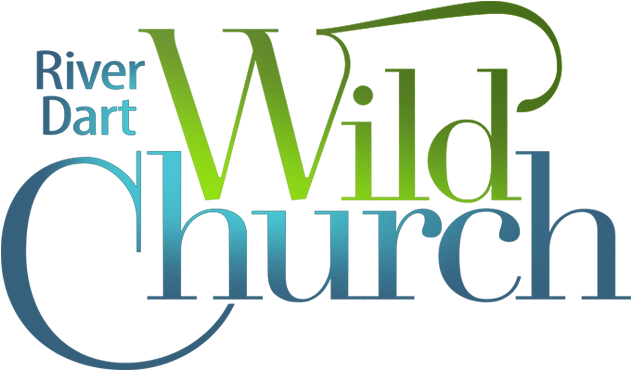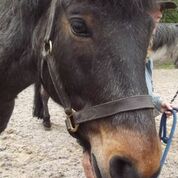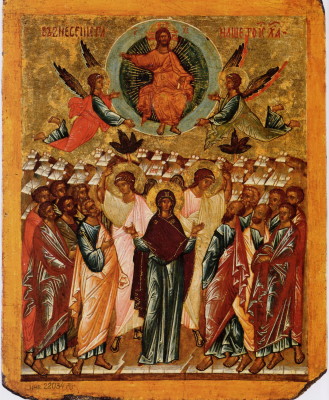
Today is the Feast of the Ascension and another wonderful celebration in the Christian ‘seasons of the spirit’. Meeting once a month means that Wild Church was a little ahead of the game for Ascension when we gathered on Sunday May 3rd but I (Sam) have appreciated starting conversations about the meaning and experience of ascension then and being able to continue to explore since.
On the face of it, for a group celebrating nature and the earth, ascending into heaven seems an unpromising image. Isn’t this seemingly transcendent tendency, and the split between matter and spirit that it often seems to suggest, part of what we are trying to heal? I’ve been grappling with understandings around ascent and descent, light and dark, spirit and matter for decades and have immersed myself in a wide range of myths and motifs that have given me a richer perspective than the stark and split dualities that we often seem to fall back on. I no longer think in terms of opposites and hierarchies, of ‘moving from darkness to light’, of ‘rising above difficulty’, of the ‘triumph of reason over base animal instinct’ or whatever such phrases we may unconsciously use in conversation and in spiritual services and celebration. For me such phrases are full of unchallenged assumptions and judgements that I can no longer support, as they can lead to equally unconscious and destructive behaviours at many levels… from apartheid to environmental damage.
Contemporary archaeologists suggest that in pre-Christian Britain when our earliest ancestors sought sacred experience they descended into the darkness beneath the earth, such as at sites like Grime’s Graves in Norfolk. Early myths that underpin Hebrew Bible stories such as those from Ancient Mesopotamia, Egypt and Greece also celebrate the sacred nature of descent and darkness in tales such as those of Inanna, Isis or Demeter & Persephone. These are myths that celebrate a sacred marriage of light and dark, of Above and Below. Which is perhaps what is really going on in this image of Ascension.
Although I fought against Christianity for many years, I finally had to acknowledge that it is rooted in exactly the sort of myths I was looking for. That it is fundamentally a faith that celebrates incarnation, not transcendence. At Christmas we celebrate finding the sacred in a stable and the divine nature of a new born child. (Anyone who has spent much time in a stable (more on this later) or been at a birth/given birth can confirm that these particular miracles are still going on.) At Easter we celebrate the indestructible nature of the human spirit, even in the face of the most terrible suffering and death. As a mythic motif, you can’t get much more affirming of the body and earthly life, than the resurrection of Christ. So why ruin a great come back with ascension, you may ask, as I have!
As a (pretty poor) student of icon painting, I’ve found help with my ascension struggles in the Eastern Orthodox tradition, where it seems the Ascension of Christ is celebrated as the culmination of the Mystery of Incarnation. Here is another great mythic motif of sacred marriage as Jesus’ human and physical nature is fully united with God in Heaven. Key point here – Jesus doesn’t ascend out of his physical body and human beingness – he takes them with him. The engagement with earthly living and loving, with all its limits and sufferings, is the journey into a resurrected and ascended life. Like all great participative myths, this motif invites us into a similar process of transformation (theosis) and affirmation – that we too can experience divine union within our ordinary lives and beings – that there is ‘a complementary nature between created and creator’. Not that this process is an easy or an automatic one. With a background in Buddhism and a deep commitment to spiritual practice, I agree with the Orthodox view that contemplative ‘prayer of the heart’ (aka mindfulness) and similar commitments enable an inner and outer transformation into a larger and more loving, more divine way or more enlightened way of being and living.
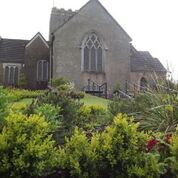
Meanwhile…back on the first Sunday of May, while such reflections were rumbling around inside me, Wild Church was gathering with the small and welcoming congregation of St. Mary’s in Holne. This is a most beautiful Church with its restored painted Rood Screen and other treasures, including their wonderful priest, Corynne, who had done a remarkable job of finding all the most earthy and celebratory hymns to welcome Wild Church to their communion service and even kindly invited me to speak in place of her sermon. (Brave soul – but everyone survived!) Corynne joined us as we set off after the service for a silent walk onto the edge of Dartmoor to visit the home of Sue Blagburn, founder of Adventures with Horses.
We climbed steadily out of Holne village, blessed with both sunshine and rain and catching glimpses of beautiful expansive views over fields and woods that stretched from the river to the moorland skyline. The moors themselves were sweet and bright with golden gorse flowers and the song of the larks. As we arrived at Middle Stoke Farm, Sue and her assistant Gemma, brought the horses down to the paddock alongside the house and humans and horses started to become aware of each other as we tucked into our respective lunches.
After lunch Sue invited us to become aware of becoming part of a herd together, of allowing ourselves to shift into a more meditative state of heart and mind and come into a more sensitive relationship with each other, the horses and the landscape. She lovingly encouraged us to allow the horses to become companions and teachers, with meditative exercises for us to open our senses as horses do and listen more fully and scent and sense the earth around us. We spent time in Sue’s sand school with horses, William and Harry, exploring and meeting without pressure… aware of both contact and the spaces between… meeting as ‘being to being’ and through touch and presence, rather than through words, which for many of us was really very freeing and quite a relief.
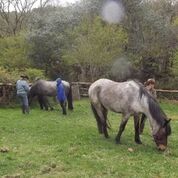 Our horse and human herd then took a mindful walk through the moorland landscape. This was my personal highlight as, encouraged by the horses, I re-discovered the wonders of grazing. Fortunately I have a good knowledge of what is edible & poisonous in the wild (without which, I don’t recommend you try this) and so was able to explore communing with the land by tasting my way around the hedgerows and meadows. There’s something wonderfully intimate and child-like in meeting plants through the touch of one’s lips, a savouring of the tenderness of spring growth, of texture and taste. Anxieties and restless thoughts died away as I settled into communion with rain washed leaves and flowers in the good company of the herd. For a short while I entered into a prayer of the heart and experienced heaven on earth. At one point I found a tiny eggshell in the moss and I thought again about ascension, of all the ways in which creatures lift their lovely earthy bodies into the heavens and for a while, it all made sense…
Our horse and human herd then took a mindful walk through the moorland landscape. This was my personal highlight as, encouraged by the horses, I re-discovered the wonders of grazing. Fortunately I have a good knowledge of what is edible & poisonous in the wild (without which, I don’t recommend you try this) and so was able to explore communing with the land by tasting my way around the hedgerows and meadows. There’s something wonderfully intimate and child-like in meeting plants through the touch of one’s lips, a savouring of the tenderness of spring growth, of texture and taste. Anxieties and restless thoughts died away as I settled into communion with rain washed leaves and flowers in the good company of the herd. For a short while I entered into a prayer of the heart and experienced heaven on earth. At one point I found a tiny eggshell in the moss and I thought again about ascension, of all the ways in which creatures lift their lovely earthy bodies into the heavens and for a while, it all made sense…
